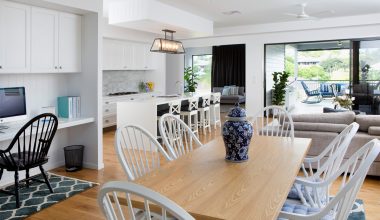Furnishing a room involves more than choosing good-looking pieces. You need to consider function as well as form
We’ve looked at the basic concepts of good design, determining style and issues of colour. It’s now time to put these principles into practice by examining a range of rooms — covering just about every part of the house — and look at how and why they work. Practicality should always reign supreme when you set out on a decorating adventure — and we do mean adventure, because sometimes the process can bring about a whole new range of contacts and experiences, all unforeseen when you make that simple decision to paint a room and update the décor.
By practicality, we mean taking into account the function and purpose of each space to be decorated. You might love thick woollen carpeting, but it makes little sense to place it in heavy traffic and wet/mud-prone areas such as at the front door, in the kitchen and bathroom, and down a busy hallway leading outside. The way you approach a room should always be in keeping with how the space is utilised, by whom (be they adults or children), and how it will blend with the décor of other rooms of the house.
There are many prerequisites of design, which extend from these practical issues.Lounge rooms and living areas should be decorated to facilitate comfort and the coming together of family members. Dining rooms should feature a goodsized table and chairs to accommodate the optimum number of diners and should be located as close as possible to the kitchen.
Entrances should have places for wet umbrellas and coats, while kitchens should be designed and laid out in such a way as to allow the free flow of movement between food storage, preparation and clean-up areas (the well-known work triangle concept). In this chapter we examine rooms to lounge in, to dine, sleep and bathe in, as well as entrances, home office spaces and home entertainment rooms created just for fun. As we go along we’ll highlight many of the key decorating techniques employed and the practicalities observed. But first we need to make a deviation — to look at an issue which relates to all rooms of the home: furniture.
Most homes are furnished progressively, never in one fell swoop in the local department or homewares store, meaning many pieces within the home have some special meaning and tell a tale because they were bought over time, at an auction here, inherited from a grandparent, picked up during an overseas trip. This aspect of a home’s décor makes it all the more significant, which is why most of us want to keep particular pieces as key elements of our decorating schemes, designing rooms around a favourite lounge, table or dresser.
This means that while we may look at a magazine photo of an amazing interior and think “I want my home to look like that” we have to understand that the finished result didn’t happen overnight. It evolved with the purchase of an armchair here, the gift of a painting there. It is always important to bear this in mind when the ‘dissatisfaction bug’ bites and you want a whole new décor.
It is also important to consider if the look you want can be achieved by ultimately embracing the key pieces you already have. It might be a matter of knowing how to arrange, colour co-ordinate and make the most of what’s at hand, adding a new item here and there. Decorating a room doesn’t automatically mean you have to hit the shops — or go online — and buy, buy, buy. Because decorating a room is an evolutionary process, you need to pace yourself and be comfortable with the concept of compromise, albeit it temporarily. Until you find the exact finishes you want and the ideal pieces, you will find you can make do with alternatives, perhaps settling for off-theshelf calico drop curtains until you can afford the slim-line Venetians or remotecontrolled sun-screen blinds you plan to install as soon as the budget allows.
When it comes to selecting furniture, English interior writer Mary Gilliatt — an accomplished designer with years of hands-on experience — suggests dividing it into ‘rooted’ pieces and ‘peripheral’ pieces. Rooted pieces are things like core room furnishings — beds, sofas, dining tables, bookcases. By peripheral pieces she means small items that add to “the overall effect of contrast — solidity and lightness, permanence and fluidity” — occasional tables, standalone chairs, coffee tables. The rooted or essential pieces should always be the first priority and, because they can be expensive, it always makes sense to aim for the best quality you can afford. You want to have them for a long time and don’t want to have to turn around and buy afresh later on. Where budget is a consideration, for major pieces such as lounge settings you might like to select colours that are neutral — a patterned and even brightly coloured lounge will dictate a certain look and not allow much change in your tastes of décor. With a neutral-coloured lounge you can update the look and feel of the room by changing the cushions or draping a coloured throw over one arm. Of course, the other option is to choose a lounge setting with removable covers for when you want a complete change.
When placing furniture into a room, consider the traffic flow in and out of the space first, thus determining where furniture shouldn’t go. Then look for a focal point and work to arrange at least some of the furniture around it — be it a fireplace, a window with a view, or a designer cabinet that contains the television and other entertainment equipment. The other option is to create your own centre of interest, perhaps arranging a sofa and chairs around a coffee table to declare a centre for conversation. It is also important to consider variations in height within any room. A bedroom will look bottom-heavy if all the furnishings — chests of drawers, bedside cabinet, chair and ottoman — are only a little taller than the bed itself. The same principle applies in the lounge, the dining room and all other parts of the house, so work to stagger furnishing heights and ‘in fill’ gaps on the wall above low chairs, tables and chests with framed images, artworks or shelves boasting glass vases or some other kind of collectable.
And always remember to be flexible. Don’t walk around town thinking your new room has to look like something out of a designer furniture catalogue or the latest Myers advertisement, and dismiss the quirky bits and pieces that will turn a room into a warm, comfortable and highly personalised place to be. After all, they don’t have those unique, one-off pieces — that antique dresser that has been passed down from generation to generation, or that amazing table you bought during your last visit to France (or Japan or Morocco) — which can add life and character to your otherwise picture-perfect contemporary room.
Approach furnishing a room with courage and a touch of ‘dare to be different’, ‘think-outside-the-box’ humour, and integrate something foreign and fun into even the most ‘pure’ of decors. Pull the whole thing together by using colour and pattern in common with other pieces in the room and you’ll be surprised how well the whole thing works — and how you have instantly added that little extra dash of personality to the space that really makes it your own. And so, on with the rooms and the decorating.




